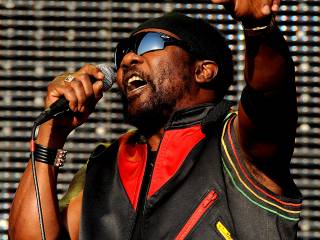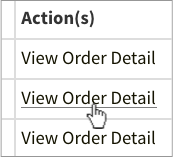Event Detail
An Acoustic Evening w/ Toots & The Maytals w/ Special Guest Anders Osborne
All Ages
Wednesday, November 7, 2012
Show at 10:00PM
Included in each ticket price is a $1 charitable donation to the Toots Foundation, a non-profit organization that raises money for the benefit of underprivileged children throughout the world.
WXRT Welcomes An Acoustic Evening with Toots & The Maytals with Special Guest Anders Osborne
Toots and the Maytals, originally called simply The Maytals, are considered legends of ska and reggae music. Their sound is a unique, original combination of gospel, ska, soul, reggae and rock. Frederick "Toots" Hibbert, the leader of the group, was born in May Pen in the Parish of Clarendon, Jamaica. He was the youngest of seven children. He grew up singing gospel music in a church choir, but moved to Kingston in 1961 at the tender age of sixteen.
In Kingston, Hibbert met Henry “Raleigh” Gordon and Nathaniel “Jerry” McCarthy, forming a group whose early recordings were attributed to “The Flames” and, possibly, “The Vikings”. Having renamed the group the Maytals, the vocal trio recorded their first album, “Never Grow Old – presenting the Maytals”, for producer Clement “Coxsone” Dodd at Studio One in 1962-63. With musical backing from Dodd’s house band, the legendary Skatalites, the Maytals’ close-harmony gospel singing ensured instant success for the 1964 release, overshadowing Dodd’s other up-and-coming gospel trio, The Wailers. The original album augmented by studio out-takes from the Studio One sessions was re-released by Heartbeat/Rounder Records in 1997, and is essential listening for Maytals and Skatalites fans.
After staying at Studio One for about two years, the group moved on to do sessions for Prince Buster (released in 1974) before recording their second album produced by Byron Lee in 1965 . However, the band’s musical career was rudely interrupted in late 1966 when Hibbert was arrested and imprisoned on drugs possession charges.
Following Hibbert’s release from jail towards the end of 1967, the band officially changed their name to Toots and the Maytals and began working with Chinese-Jamaican producer Leslie Kong, a collaboration which produced three classic albums and a string of hits throughout the late sixties and early seventies – “Do the Reggay”, a 1968 single widely credited with coining the word reggae, “Pressure Drop”, “54-46 was my number” and “Monkey Man”, the group’s first international hit in 1970 . The group was featured in one of reggae’s greatest breakthrough events – The Harder They Come, the 1972 film and soundtrack starring Jimmy Cliff, named as one of Vanity Fair’s Top 10 Best Soundtracks of all time.
Following Kong’s death in 1971, the group continued to record with Kong’s former sound engineer, Warwick Lyn; produced by Lyn and Chris Blackwell of Island Records, the group released three best-selling albums, and enjoyed international hits with Funky Kingston in 1973 and Reggae Got Soul in 1976.
Toots and the Maytals’ compositions would be given a second airing in 1978-80 during the reggae-punk and ska revival period in the UK, when The Specials included “Monkey Man” on their 1979 debut album and The Clash produced their version of “Pressure Drop”. Having toured throughout the world for many years, Toots and the Maytals disbanded in the early 1980s, but reformed in the early 90s to continue touring and recording successfully. Sublime recorded cover versions of some Maytals songs in the 1990s as well.
The band recently won the 2005 Grammy award for best reggae album True Love, an album consisting of re-recorded versions of their classics alongside popular and legendary musicians such as Bonnie Raitt, Willie Nelson, Eric Clapton, and Keith Richards, as well as popular artists today such as No Doubt, Ben Harper, The Roots, and Shaggy.
Toots and the Maytals remains a relevant influence on today’s global music scene with artists from Amy Winehouse to Sublime re-recording classic tracks. Toots recieved another Grammy nomination for his 2008 release “Light Your Light. In recent years Toots has toured with The Rolling Stones, Dave Matthews, Sheryl Crow and Los Lonely Boys.
Always recording when not touring, “Flip & Twist” was released in 2010 on Toot’s own D & F Music label.
-
Between the sheer force and potent lyricism of his guitar playing, the riveting depth of his songwriting and the straight-from-the-soul conviction of his vocals, New Orleans’ Anders Osborne is among the most original and visionary musicians writing and performing today. Relix says Osborne plays “hard-hitting songs” featuring his “raging, expressive guitar and soulful singing…from scorched-earth rock to sweet, tender ballads.”OffBeat magazine recently named Osborne the Crescent City’s Best Guitarist for the second straight year, and also awarded him with the Best Roots Rock Artist title. Guitar Player called him, “The poet laureate of Louisiana’s fertile roots music scene.”
Since the release of his 2010 Alligator Records debut, American Patchwork, Osborne has toured virtually non-stop, performing with his own band, solo with Keb Mo, with The Stanton Moore Trio, alongside Karl Denson’s Tiny Universe and with Luther Dickinson as well as with The Voice Of The Wetlands All-Stars. He appears on Galactic’s song “Dark Water” from their Ya-Ka-May album, and in 2011 produced and played on critically acclaimed albums by Tab Benoit, Johnny Sansone and Mike Zito. Along the way, he also found time to write and record the next chapter in his still-unfolding career, Black Eye Galaxy.
Recorded at the famed Dockside Studio in Maurice, Louisiana, Black Eye Galaxy was produced by Anders along with engineer Warren Riker and Galactic’s Stanton Moore. Sounds on the album range from heavy electric mayhem to joyous acoustic melodicism, lyrics move from the darkest depths to the healing power of love. Black Eye Galaxy is a personal record for Osborne, but one with universal themes. “It’s about being on the other side of chaos and putting things back together,” he says. The title is an unambiguous metaphor for Osborne’s life as a traveler, a musician, an immigrant, a recovering addict, and as a husband and father.
The album is a journey of sorts, following the main character (based on Anders’ own life experiences) from the uncontrolled, primal chaos of “Send Me A Friend”to the inner peace of “Higher Ground.” The disjointed and brutally honest “Mind Of A Junkie” leads into the warm and hopeful “Lean On Me/Believe In You.” The gentle “When Will I See You Again?” finds Anders rebuilding broken relations, while the feral and confrontational “Black Tar” (co-written with Little Feat’s Paul Barrere) says farewell to a dark past. The final four songs — “Tracking My Roots,” “Louisiana Gold,” “Dancing In The Wind,” and “Higher Ground” — bring an almost ecstatic tranquility after the intense stress and turbulence of the beginning of the album. From ultra-heavy and challenging to sweetly soul-soothing and melodic, Osborne’s guitar work, like his vocals, is simply mesmerizing. Black Eye Galaxy is a harrowing but ultimately uplifting cycle of richly detailed songs that are musically and lyrically thought-provoking, exhilarating and completely engaging.
Live, Osborne is a force to behold. His wildly energetic, physical performances find him ripping notes out of his guitar, forcing out intense steel-on-steel slide solos, pouring his entire soul into his vocals. His piercing guitar playing, slide work and fluid finger picking (oftentimes happening simultaneously) are simply unmatched. His use of Open D tuning (a rare choice for a guitar virtuoso) gives his fretwork a signature sound and feel. “I first heard Open D on Joni Mitchell’s Blue,” he says, “and my fingers just fit the tuning.” His influences range from Ry Cooder and Robert Johnson to the great horn players like Miles Davis and John Coltrane.
Past gigs include repeated appearances at The New Orleans Jazz & Heritage Festival, stops at Bonnaroo, The High Sierra Festival, The Telluride Blues Festival, The Hollowbaloo Music & Arts Festival in Honolulu, The Voice Of The Wetlands and an appearance at the 2008 Democratic National Convention. He has toured North America and Europe extensively, and is constantly in demand as a guitarist, songwriter and producer.
Since his recording debut in 1989, Osborne has written virtually all of his own material and contributed memorable songs to a wide variety of artists. Two tunes co-written by Osborne appear on blues great Keb Mo’s Grammy-winning 1999 release Slow Down. Country superstar Tim McGraw scored a #1 hit with Anders’ song “Watch The Wind Blow By.” Osborne’s compositions have been covered by artists as diverse as Brad Paisley, Tab Benoit, Jonny Lang and Kim Carnes. His song “What’s Going On Here” appeared in the 1996 feature film Fled, and Osborne, along with Ivan Neville, wrote and recorded the title track for the 2010 Kate Hudson film Earthbound. He can also be seen performing in a recent episode of HBO’s New Orleans-based drama, Treme.
Osborne was destined to live in New Orleans, and it’s no surprise he’s become one of the city’s favorite sons. His path home, however, was a long and winding one. He was born in Uddevalla, Sweden in 1966. His father was a professional touring jazz drummer who played all over Europe and was exposed to a lot of styles of popular American music. He brought home reel-to-reel recordings of jazz, R&B and early rock ‘n’ roll from artists as diverse as Little Richard, Fats Domino, Bill Haley, Art Pepper and Miles Davis. As a teen, Anders started playing guitar and listening to Bob Dylan, Neil Young, Jackson Browne, and Joni Mitchell records. He fell in love with the vocal styles of Ray Charles, Van Morrison and Lowell George. Then he heard the blues of Robert Johnson and recordings of African drumming, and suddenly, everything clicked. “Blues connected everything together for me,” Osborne recalls. “The early rock, the R&B, the jazz, the singer-songwriters. Blues was like a thread running through everything.”
With a serious case of wanderlust, Anders began traveling on his own at 16. For the next four years, he hitchhiked across Europe, North Africa, Southeast Asia and the Middle East, earning money by doing odd jobs and performing on the street or in bars at every opportunity. He worked assembly lines in Israel and dug ditches in Greece. He picked fruits and vegetables in many locales, following the harvest seasons across Europe. He wrote constantly, soaking up the life experience and honing his craft.
In 1985, after landing in New York with only $5.00 in his pocket, Osborne hitchhiked to New Orleans to meet up with a friend. “Once I got to New Orleans, everything I heard in my head — the music, the way people treated each other — was happening. I knew I was home.” He naturally absorbed the spirit of the Crescent City into his soul, as he was fully embraced by the city’s vibrant music community. Shortly after moving there, he found out that his grandfather, a sailor, had lived in New Orleans for many years. His grandfather then began telling him vivid stories of the city, and sharing old photographs. “I just felt connected to his memories,” Osborne says, “and I knew I was where I was supposed to be.”
Anders spent his first few years in New Orleans writing and developing his sound and style, all the while continuing to soak up the music of the city. He cut his first two albums for the independent New Orleans-based Rabadash Records in 1989 and 1993. The excitement surrounding those releases led to a major label deal with Sony’s Okeh imprint in 1995. Osborne released a series of successful albums for Shanachie and MC Records, all to wide critical and popular acclaim, before joining forces with Alligator Records.
With the 2010 release of American Patchwork, Osborne’s fame suddenly reached a whole new level. Critics went wild, with OffBeat saying, “American Patchwork is the album Osborne fans have been waiting for. The record is a focused and tuneful triumph. Osborne’s gifts as a guitar player are significant. His voice is so emotionally intense it feels like an explosion. He writes with remarkable eloquence…this is the living definition of great art.”In the studio and in concert, Anders Osborne channels the music throughout his entire body, becoming a whirling dervish of pure energy. Blurt says, “This is modern music at its transcendent best.” Paste adds, “He is wildly diverse, thoughtful and raw.” With Black Eye Galaxy, Osborne’s star has exploded into the universe, fully formed and spinning freely in its own unique direction.





